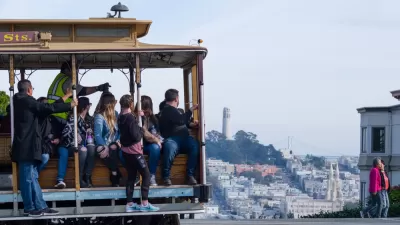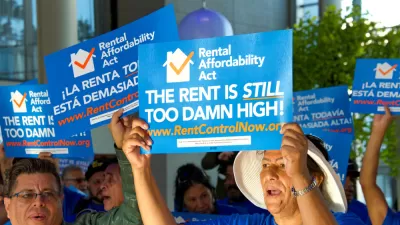In California, rent control continues to be a hotly contested issue at both the local and state levels.
Liam Dillon traces the fight for rent control in the Silicon Valley city of Mountain View. After Mountain View voters passed a 2016 ballot initiative to control rent hikes, landlords launched an unsuccessful legal attempt to have it overturned. Then they tried to put another measure on the November ballot:
Their proposed initiative would limit rent control to households making less than the city’s median income, and suspend the system if the city had too many vacant rentals. Under the standard, rent control would only be in effect if fewer than 3% of rental units in the city were vacant — a level that hasn’t been reached since 2012, per U.S. Census data.
They were not able to get it on the ballot this year, so they are looking to 2020. In the meantime, California voters in November will decide on a state initiative, Proposition 10, which seeks to repeal the Costa-Hawkins Rental Housing Act. The law stymied most types of rent control by limiting it to buildings constructed before 1995, excluding single-family homes, and freezing rent control in some cities.
As the Proposition 10 battle rages on, rent control remains in place in Mountain View. “The city limits annual rent hikes in those apartments to an inflation figure set by the rent board the initiative established, and landlords are able to petition the board for larger increases to finance improvements,” reports Dillon.
For some renters, rent control allowed them to stay in Mountain View when otherwise they would have been priced out. Opponents say that landlords are more inclined to sell their properties to developers. But, says Dillon, the data do not fully support this argument or the claims that rent control will cause new housing construction to decrease.
FULL STORY: What a rent control fight in Silicon Valley could mean for the rest of California

Study: Maui’s Plan to Convert Vacation Rentals to Long-Term Housing Could Cause Nearly $1 Billion Economic Loss
The plan would reduce visitor accommodation by 25,% resulting in 1,900 jobs lost.

North Texas Transit Leaders Tout Benefits of TOD for Growing Region
At a summit focused on transit-oriented development, policymakers discussed how North Texas’ expanded light rail system can serve as a tool for economic growth.

Why Should We Subsidize Public Transportation?
Many public transit agencies face financial stress due to rising costs, declining fare revenue, and declining subsidies. Transit advocates must provide a strong business case for increasing public transit funding.

How to Make US Trains Faster
Changes to boarding platforms and a switch to electric trains could improve U.S. passenger rail service without the added cost of high-speed rail.

Columbia’s Revitalized ‘Loop’ Is a Hub for Local Entrepreneurs
A focus on small businesses is helping a commercial corridor in Columbia, Missouri thrive.

Invasive Insect Threatens Minnesota’s Ash Forests
The Emerald Ash Borer is a rapidly spreading invasive pest threatening Minnesota’s ash trees, and homeowners are encouraged to plant diverse replacement species, avoid moving ash firewood, and monitor for signs of infestation.
Urban Design for Planners 1: Software Tools
This six-course series explores essential urban design concepts using open source software and equips planners with the tools they need to participate fully in the urban design process.
Planning for Universal Design
Learn the tools for implementing Universal Design in planning regulations.
City of Santa Clarita
Ascent Environmental
Institute for Housing and Urban Development Studies (IHS)
City of Grandview
Harvard GSD Executive Education
Toledo-Lucas County Plan Commissions
Salt Lake City
NYU Wagner Graduate School of Public Service





























